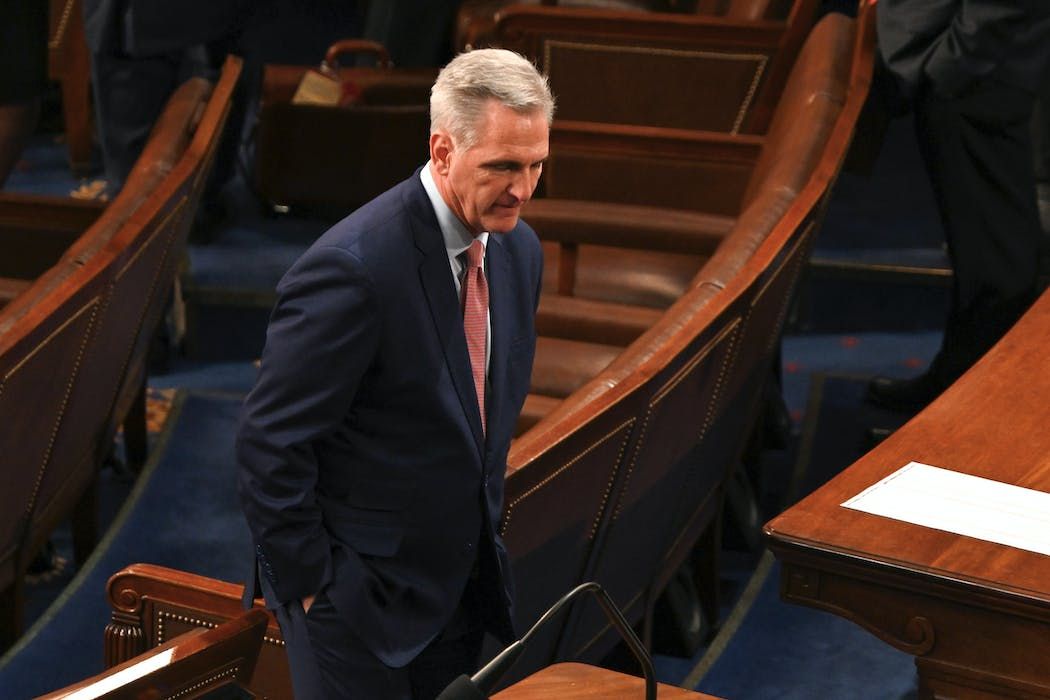The whole system of online passwords is dumb and unsafe.
0 Comments
I will always be a fan of making New Year's resolutions.
|
YELLEN WARNS U.S. HAS HIT DEBT CEILING |
Washington is gearing up for another big fight over whether to raise or suspend the nation's debt limit, with Treasury Secretary Janet Yellen telling Congress on Thursday that the United States had reached its existing borrowing cap of $31.4 trillion.
Yellen sent a letter to Congress saying the Treasury will begin using "extraordinary measures" — suspending some investments and exchanging different types of debt — to try to stay beneath the cap for as long as possible. But eventually, the United States will need to either borrow more money to pay its bills or stop making good on its financial obligations, including possibly defaulting on its debt.
Responsibility for lifting or suspending the borrowing cap falls to Congress, which must get a simple majority in both the House and Senate to vote for any change to the debt limit.
This year is shaping up to be the messiest fight in at least a decade. Republicans now control the House, and they have adopted new rules governing legislation that make it more difficult to raise the debt limit and that strengthen Republicans' ability to demand that any increase be accompanied by spending cuts. Senate Republicans have also insisted that increases to the debt limit should be tied to "structural spending reform."
President Joe Biden has said he will oppose any attempt to tie spending cuts to raising the debt ceiling, raising the likelihood of a protracted standoff.
All of this drama raises the question of what the debt limit really is, how it got here and why the United States does not do away with a debt limit entirely and spare the nation from its periodic faceoff with an economic time bomb.
What is the debt limit?
The U.S. borrows huge sums of money by selling Treasury bonds to investors across the globe and uses those funds to pay existing financial obligations, including military salaries, safety net benefits and interest on the national debt.
The debt limit is a cap on the total amount of money that the federal government is authorized to borrow to fulfill its financial obligations. Because the United States runs budget deficits — meaning it spends more than it brings in through taxes and other revenue — it must borrow huge sums of money to pay its bills. The debt ceiling debate often elicits calls by lawmakers to cut back on government spending, but lifting the debt limit does not authorize any new spending and in fact simply allows the United States to finance existing obligations.
When was the debt limit breached?
The U.S. hit its technical debt limit Thursday, prompting the Treasury Department to begin using "extraordinary measures" to continue paying the government's obligations. Those are essentially fiscal accounting tools that curb certain government investments so that the bills continue to be paid.
Those options could be exhausted by June, Yellen told Congress last week. The Bipartisan Policy Center, which closely tracks the debt limit deadline, estimates that the Treasury will really run out of cash — what's known as the X-date — sometime around the middle of the year.
How much debt does the United States have?
The national debt crossed $31 trillion for the first time last year. The borrowing cap is set at $31.381 trillion.
What happens if the debt limit is not lifted or suspended?
Once the government exhausts its extraordinary measures and runs out of cash, it would be unable to issue new debt. That means it would not have enough money to pay its bills, including interest and other payments it owes to bondholders, salaries for troops and benefits to retirees.
No one knows exactly what would happen if the United States gets to this point, but the government could wind up defaulting on its debt if it is unable to make required payments to its bondholders. Economists and Wall Street analysts warn that such a scenario would be economically devastating and could plunge the globe into a financial crisis.
Can the government do anything to forestall disaster?
There is no official playbook for what Washington could — or would — do if the United States is unable to pay its bills. But options do exist. The Treasury could try to prioritize payments, such as paying bondholders first. Still, such an idea has yet to be tested and would require political decisions about who gets paid and who doesn't.
If the United States does default on its debt, which would rattle the markets, the Federal Reserve could theoretically step in to buy some of those Treasury bonds. That could help calm what would undoubtedly be panic in the Treasury markets and elsewhere.
Why does the United States limit its borrowing?
According to the Constitution, Congress must authorize borrowing. The debt limit was instituted in the early 20th century so the Treasury did not need to ask for permission each time it needed to issue bonds to pay bills. The first debt limit came as part of the 2nd Liberty Bond Act of 1917, according to the Congressional Research Service. A general limit on the federal debt was imposed in 1939.
Do other countries do it this way?
Denmark also has a debt limit, but it is set so high that raising it is generally not an issue. Most other countries do not. In Poland, public debt cannot exceed 60% of gross domestic product.
Why is raising the debt limit so difficult?
For many years, raising the debt ceiling was routine. But as the political environment has become more polarized, brinkmanship over the debt ceiling has increased. The House used to employ the "Gephardt Rule," which required the debt limit to be raised when a budget resolution was passed, but that was for the most part phased out during the 1990s.
During the 2011 debt-ceiling battle, some argued that then-President Barack Obama had the power to unilaterally lift the debt ceiling. Former President Bill Clinton said at the time that if he were still in office, he would invoke the 14th Amendment, which says the validity of U.S. debt shall not be questioned, raise the debt ceiling on his own and force the courts to stop him.
Obama and his lawyers disagreed and opted against that approach. After leaving office, Obama acknowledged that he and Treasury officials considered several creative contingency plans, such as minting a $1 trillion coin to pay off some of the national debt. In a 2017 interview, he described the idea as "wacky."
Would it be a good idea to do away with the debt limit?
Few lawmakers from either party enjoy a vote on the debt ceiling, and the default that would be caused by a failure to raise it would lead to an economic catastrophe. With political polarization in the United States showing no signs of abating, it often seems that the risk of an accidental default outweighs any fiscal responsibility that the debt limit encourages.
Yellen has said she would support legislation to abolish the debt limit, but Biden has ruled that out.
House Republicans prepare emergency plan for breaching debt limit The plan, previously unreported, was part of the private deal reached this month to resolve the standoff between House conservatives and Rep. Kevin McCarthy (R-Calif.) over the election of House speaker. |
House Republicans are preparing a plan telling the Treasury Department what to do if Congress and the White House don't agree to lift the nation's debt limit later this year, underscoring the brinkmanship newly empowered conservatives will bring to the high-stakes negotiations over averting a U.S. default, according to six people aware of the internal discussions.
The plan, which was previously unreported, was part of the private deal reached this month to resolve the standoff between House conservatives and Rep. Kevin McCarthy (R-Calif.) over the election of House speaker. Rep. Chip Roy (R-Tex.), a leading conservative who helped broker the deal, told The Washington Post that McCarthy agreed to pass a payment prioritization plan by the end of the first quarter of the year.
The emerging contingency plan shows how Republicans are preparing to threaten not to lift the nation's debt ceiling without major spending cuts from the Biden administration. Congress must pass a law raising the current limit of $31.4 trillion or the Treasury Department can't borrow any more, even to pay for spending lawmakers have already authorized. Economists warn that not raising the debt limit could cause the United States to default, sparking a major panic on Wall Street and leading to millions of job losses.
Treasury Secretary Janet L. Yellen said Friday said that the Treasury Department will begin "extraordinary measures" next week to ensure the federal government is able to meet its payment obligations but that it cannot guarantee the United States will make it beyond early June without defaulting. White House press secretary Karine Jean-Pierre reiterated Friday that the administration will not negotiate over the debt ceiling.
Treasury Department aides declined to comment on the GOP plan, and a spokesman for McCarthy did not return requests for comment.
In the preliminary stages of being drafted, the GOP proposal would call on the Biden administration to make only the most critical federal payments if the Treasury Department comes up against the statutory limit on what it can legally borrow. For instance, the plan is almost certain to call on the department to keep making interest payments on the debt, according to four people familiar with the internal deliberations who spoke on the condition of anonymity to describe private conversations. House Republicans' payment prioritization plan may also stipulate that the Treasury Department should continue making payments on Social Security, Medicare and veterans benefits, as well as funding the military, two of the people said.
Such a move would be unprecedented and hugely controversial, and even releasing the plan could turn into a major political liability for the GOP. A hypothetical proposal that protects Social Security, Medicare, veterans benefits and the military would still leave out huge swaths of critical federal expenditures on things such as Medicaid, food safety inspections, border control and air traffic control, to name just a handful of thousands of programs. Democrats are also likely to accuse Republicans of prioritizing payments to U.S. bondholders - which include Chinese banks - over American citizens.
"Any plan to pay bondholders but not fund school lunches or the FAA or food safety or XYZ is just target practice for us," a senior Democratic aide said, speaking on the condition of anonymity to discuss a proposal that hasn't yet been released publicly.
McCarthy and House conservatives intentionally left the details of the prioritization plan unsettled in their initial agreement, with the understanding that it could take weeks for Republicans to decide which federal spending programs must be protected, the two people familiar with the talks said, and amid uncertainty about the best way to draft the legislation.
The idea poses logistical hurdles as well. In 2011 and 2013, when similar debt ceiling crises loomed, Treasury Department officials in the Obama administration said prioritizing payments was not technically possible, given the complexity of the millions of payments the federal government makes each day.
For the plan to be binding on the Treasury Department, it would have to pass not only the House but also the Democratic-controlled Senate, and President Biden would have to sign it into law.
Even if it were enacted, a debt prioritization plan could still jeopardize the trustworthiness of the U.S. government, some experts say. The proposal would call for the government to halt payment for as much as 20 percent of money that it has already promised to spend.
Still, many Republican lawmakers have long favored exploring these kinds of measures as a way to mitigate the worst economic consequences of breaching the debt ceiling. Two of the people with knowledge of internal GOP planning said the prioritization plan would force Democrats to acknowledge that it is technically possible for the Treasury Department to continue to pay bondholders even if Congress doesn't raise the debt limit.
One of these people noted that interest payments amount to roughly $500 billion per year, which can be easily met through federal revenue without additional borrowing. Republicans have explored various ways to push prioritized debt payments over the years. Rep. Tom McClintock (R-Calif.) released a bill in 2011, called the Default Prevention Act, that would require the Treasury Department to borrow above the debt limit to ensure that interest on the debt gets paid no matter what.
That version of the plan, however, might not win universal support even among Republicans, some of whom view it as circumventing the intention of the debt limit. McClintock reintroduced the bill this week. More than a half-dozen House Republicans voted against his legislation in 2015. "We agreed to advance a debt prioritization bill through regular order by the end of the first quarter of 2023," Roy said in a text message to The Post. "Now, the contours of that were not specified (there are different versions)." Grover Norquist, founder and president of Americans for Tax Reform, a conservative advocacy group, said GOP lawmakers have stepped up discussions in recent days over a debt prioritization plan.
Then-Sen. Patrick J. Toomey (R-Pa.) proposed a similar idea during the debt ceiling showdowns with the Obama administration in 2011 and 2013. At the time, Treasury Secretary Jack Lew said government computer systems could not be updated to triage tens of millions of payments, arguing that "prioritization is just default by another name."
Republicans said those claims were exaggerated to get them to back off their debt limit threats. "The reason you do this is to say, 'We offered you a bill that prioritized things, and this is what we're getting instead of that,'" Norquist said. "It's being talked about by leadership because it is necessary to be prepared. If you come to an impasse, you want a fallback position." These efforts are expected to prove controversial even among some GOP allies.
Neil Bradley, executive vice president of the U.S. Chamber of Commerce, said the business group opposes prioritizing payments. "Prioritization doesn't work. We had this discussion a decade ago," Bradley said. "If the U.S. government skips its payments to America's seniors or skips its payments to bondholders, both of those things call into question the full faith and credit of the United States government and our commitment to paying our bills. And both of them have pretty catastrophic economic consequences."
Some Republican policy experts have been convinced such efforts would fail. Brian Riedl, a policy analyst at the Manhattan Institute, studied prioritization plans at length while he was a staffer in the offices of then-Sen. Rob Portman (R-Ohio).
Riedl said such a plan would involve lopping off about 20 percent of federal spending immediately, or about $1 trillion, because revenue covers only roughly 80 percent of the $5 trillion the government spends each year.
Huge numbers of people could be hurt immediately, he said, with no good way to pick between options such as forcing hospitals to deal with the cessation of Medicare payments or depriving the Defense Department of funding. "Studying this in 2011 convinced us this would be a really bad idea and something we really did not want to happen," Riedl said. "We didn't end the exercise saying, 'This is feasible and smart.' We said, 'Let's avoid this at all costs because it's going to be a disaster.'"
Michael Strain, an economist at the American Enterprise Institute, a conservative-leaning think tank, said the prioritization plan is a "live option" among some GOP officials and is being discussed quietly. Strain acknowledged that financial markets may not be assuaged by the government meeting only some of its spending obligations but said that could prove better than the alternative of a default on U.S. interest payments. "If we have a budget deficit of 10 percent, we should be able to cover 90 percent of our spending obligations," Strain said. "If the National Park Service or FBI don't make the cut before a deal is signed, that'd obviously be better than paying no bills."
Other longtime GOP policy hands are more apprehensive. "We will see zillions of ads about this," said Doug Holtz-Eakin, an economic adviser to President George W. Bush.
Every one of us will run into an unexpected tech issue in the new year. It might be a minor glitch, a life-altering hack or literally any printer. There are, however, a few things we can do now to make existing online in 2023 a little less stressful. For the past year, the Washington Post's Help Desk team has reviewed thousands of your technology questions, big and small. Based on all our reader emails, calls and comments, here are some big takeaways of things that could have prevented some of the most vexing issues.
Lower chances of being scammed
Whether it was by hackers taking over Facebook accounts or scammers asking for money on the phone, there's no one easy fix to avoid these situations.Hackers and scammers work nonstop to adapt and find new weak points. But you can do a few things to make it less likely.
* Turn on multifactor authentication for online accounts, especially all social media and anything that involves financial transactions.
* Do some password maintenance by updating any that may have been compromised and changing reused passwords. Set up a password manager or get a notebook started.
* Brush up on the signs something is a scam and stay on top of the latest scam trends.
Prepare for your death
Nobody wants to start a new year thinking it might be their last. But making sure that your photos and accounts can be accessed should the worst happen will mean everything to your family. It's also fairly easy and quick!
* Add legacy contacts for Apple, Google, Facebook and any password managers.
* If you have done this in the past, make sure all the names are still current and people you trust. If you have a will, add instructions for your digital legacy.
Prepare for your devices to die
You should also be ready for any worst-case scenarios involving your phone or computer, and find ways to extend their lives.
* Turn on automatic backups for all devices and make sure you have systems for important things such as your photos and text messages.
* Make sure your devices are password protected and that info tracking is turned off in case they are stolen.
* Don't just get rid of your old smartphone when something new comes out. Find out if you really need that new phone or if there's some life in your existing one. A new battery goes a long way.
* If you are getting rid of an old device, make sure you are disposing of any hardware in the most ethical way possible.
Have tech talks with your children
Being a parent of a child in the smartphone age can be a minefield, and there's no one-fits-all path for each family. However, there are some things you can start doing now to make the process smoother for everyone involved. Even if you don't give them access to a phone yet, they will find ways to access the internet. You want to be the first to tell them what's out there, not the last.
* Start working the big topics into daily conversations: online etiquette, talking to strangers online, bullying, the dangers of sexting and even pornography.
* Give them the basics on how to spot misinformation (a good refresher for people of all ages).
* Talk to teens about mental health content and what to listen to, and be wary of, on TikTok and Instagram.
Set up older family members for success
If you are the go-to tech support for other family members, you may be especially in-demand after the holidays when they have received new gadgets. If you are together, this is the best time to run through the basics and make sure the coming year is smooth. Maybe fit in a little talk about their screen-time habits.
* Put together a checklist of things to do for your family members now, including updating the software on all of their devices and making sure their passwords are in order.
* Find a local tech-support option, like a computer store that makes house calls and set up an account.
* Set up screen-sharing options for their devices so if you are far away, you can still do some troubleshooting.
Lock down your privacy online
Protecting our online privacy is, unfortunately, a never-ending job. We are constantly at odds with tech companies that profit off collecting and selling our data, and reigning it in means constantly checking settings and remembering best practices. Here's what you can do to start the year sharing as little as possible.
* Use an online privacy guide to see what settings you need to change in each app.
* Remove your personal information from Google searches with new tools the company added in the past year.
* Opt out of data brokers, learn how to read a privacy policy, and exercise any extra privacy rights you have depending where you live.
As the coronavirus pandemic approaches its third full winter, two studies reveal an uncomfortable truth: The toxicity of partisan politics is fueling an overall increase in mortality rates for working-age Americans.
In one study, researchers concluded that people living in more conservative parts of the United States disproportionately bore the burden of illness and death linked to COVID-19. The other, which looked at health outcomes more broadly, found that the more conservative a state's policies, the shorter the lives of working-age people.
The reasons are many, but, increasingly, it is state — and not just federal — policies that have begun to shape the economic, family, environmental and behavioral circumstances that affect people's well-being. Some states have expanded their social safety nets, raising minimum wages and offering earned income tax credits while using excise taxes to discourage behaviors — such as smoking — that have deleterious health consequences. Other states have moved in the opposite direction.
Researchers say the result of this growing polarization is clear: The nation's overall health profile is going from bad to worse.Americans can expect to live as long as they did in 1996 — 76.1 years, with life spans truncated by higher rates of chronic illnesses, deaths in childbirth and COVID.
"I'm not doing this research to be partisan, simplistically supporting one party or another," said Nancy Krieger, a social epidemiologist at the Harvard T.H. Chan School of Public Health and a co-author on one of the two studies. "This is about looking at the behavior of different actors, some of whom have a lot more power than others to set standards, make demands and allocate resources."
Krieger said it is fair for people to ask their elected officials, "Are you doing what you should to protect our health?"
Harvard researchers analyzed data on COVID-19 mortality rates and the stress on hospital intensive care units across all 435 congressional districts from April 2021 to March 2022. They also examined congressional members' overall voting records and whether the governor's office and legislature of a state were controlled by one party.
The study, published this month in the Lancet Regional Health-Americas, found that the more conservative the voting records of members of Congress and state legislators, the higher the age-adjusted COVID mortality rates — even after taking into account the racial, education and income characteristics of each congressional district along with vaccination rates.
The division in American politics has grown increasingly caustic and polarized, but it wasn't always this way.
From the 1930s to the 1970s, there were major investments to improve the lives of vulnerable people nationwide. The Social Security Act of 1935. Medicare and Medicaid in 1965. Before these federal programs, the nation was a hodgepodge of state programs that varied widely, said University of Washington political scientist Jake Grumbach, a co-author of a study on the effects of state policy on the mortality of working-age adults published in October in the journal PLOS One.
The report found that if all states implemented liberal policies on the environment, gun safety, criminal justice, health and welfare, labor, marijuana, and economic and tobacco taxes, more than 170,000 lives would have been saved in 2019. On the flip side, if states went with conservative versions of those policies, there would have been about 217,000 more deaths that year .
Midterm ballot initiatives showed the direct role voters can play in determining state health policy. South Dakota voters passed a measure to expand Medicaid, joining voters in six other states who previously insisted a wider pool of people be eligible for health insurance than allowed under the Affordable Care Act.
Archives
July 2024
June 2024
April 2024
March 2024
February 2024
January 2024
December 2023
November 2023
October 2023
September 2023
August 2023
July 2023
June 2023
May 2023
April 2023
March 2023
February 2023
January 2023
December 2022
November 2022
October 2022
September 2022
August 2022
July 2022
June 2022
May 2022
April 2022
March 2022
February 2022
January 2022
December 2021
November 2021
October 2021
September 2021
August 2021
July 2021
June 2021
May 2021
April 2021
March 2021
February 2021
January 2021
December 2020
November 2020
October 2020
September 2020
August 2020
July 2020
June 2020
May 2020
April 2020
March 2020
February 2020
January 2020
December 2019
November 2019
October 2019
September 2019
August 2019
July 2019
June 2019
May 2019
April 2019
February 2019
January 2019
December 2018
November 2018
October 2018
September 2018
August 2018
July 2018
June 2018
May 2018
April 2018








 RSS Feed
RSS Feed